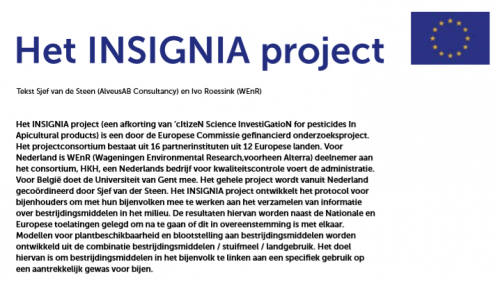Monitoring for pesticides through different matrixes in a honey bee colony is a sensible way to see what kind and quantities of pesticides are used in the field and eventually end up in the honey bee colony.
From the other side, monitoring the development of the colony and the bees behaviour is a way also to see the effects of the pesticides. Remote monitoring and precision apiculture is very much in ‘fashion’ these days. Temperature, humidity and colony weight are the most common features in a remote censoring, vibrations and sounds are getting in to the game as well, more and more.
Here is a remote monitoring system for temperature, humidity and sounds, could they tell us something about bees’ reaction to the pesticides entering the colony?
Still to be determined!
Fani Hatjina


 Belgium is one of the countries in which nine apiaries will be selected for the 2020 trials. The Flemish beekeepers were informed about the Insignia project in October 2019. Beekeeping in Flanders is much more developed than the front page of the magazine suggests. It is a giant step from making straw skeps to applying honeybee colonies as a monitoring tool for pesticides. An application of the honeybee, completely non-existing when the straw skeps were developed some centuries ago. The big difference between beekeeping with the skep and the Insignia study is that bees in the skep were killed to harvest the honey and that the Insignia project aims to result in a non-invasive (= no bees sampled and killed) citizen scientist sampling protocol; a progress in bee- welfare and bee research.
Belgium is one of the countries in which nine apiaries will be selected for the 2020 trials. The Flemish beekeepers were informed about the Insignia project in October 2019. Beekeeping in Flanders is much more developed than the front page of the magazine suggests. It is a giant step from making straw skeps to applying honeybee colonies as a monitoring tool for pesticides. An application of the honeybee, completely non-existing when the straw skeps were developed some centuries ago. The big difference between beekeeping with the skep and the Insignia study is that bees in the skep were killed to harvest the honey and that the Insignia project aims to result in a non-invasive (= no bees sampled and killed) citizen scientist sampling protocol; a progress in bee- welfare and bee research.





